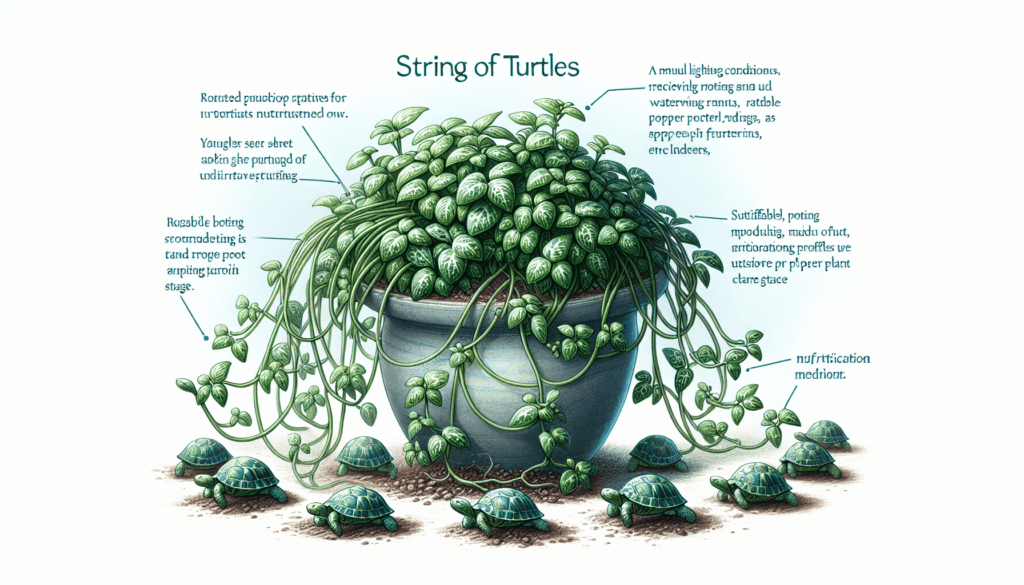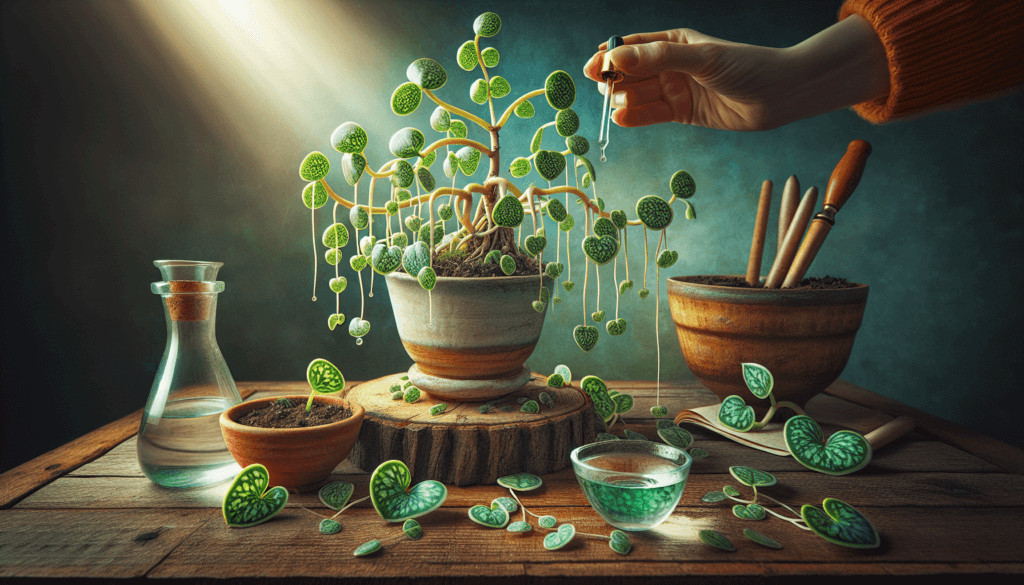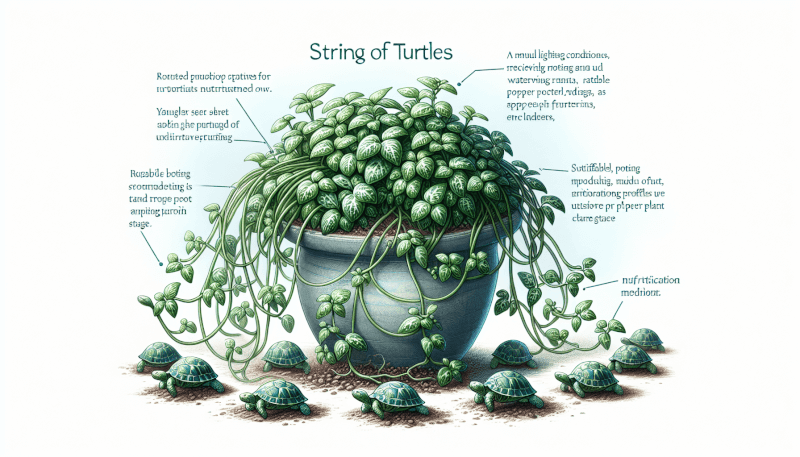So you have a beautiful String Of Turtles plant gracing your home, and now you’re wondering how to take care of this quirky green companion? Well, fret not! In this article, we will guide you on the ins and outs of String Of Turtles plant care, ensuring that you have the knowledge and confidence to keep your little green marvel looking its absolute best. From lighting and watering to propagation tips, we’ve got you covered. So sit back, relax, and let’s dive into the wonderful world of String Of Turtles plant care!
Introduction
String of Turtles plants, scientifically known as Peperomia prostrata, are unique and visually appealing houseplants that have gained popularity in recent years. Named after their round, succulent-like leaves that resemble tiny turtles strung together, these plants make for a stunning addition to any indoor space. In this comprehensive guide, we will explore the various aspects of string of turtles plant care, including their light requirements, watering needs, soil and potting, temperature and humidity preferences, fertilizing tips, pruning and propagation methods, common pests and diseases, troubleshooting techniques, and conclude with a summary of caring for these beautiful plants.
Overview of String of Turtles Plant
The string of turtles plant, a member of the Piperaceae family, is native to South America. It is a trailing plant with long, thin stems that can grow up to 12 inches in length. Each stem is adorned with small, succulent-like leaves that have a unique pattern resembling turtle shells. These leaves are predominantly green, with silver-gray markings that give the plant its distinctive appearance. String of turtles plants are not only visually appealing but also relatively easy to care for, making them a popular choice among both beginner and experienced plant enthusiasts.
Popularity and Unique Appearance
The string of turtles plant’s popularity can be attributed to its striking appearance and resemblance to tiny turtles strung together. The intricate pattern and coloration of its leaves make it a true eye-catcher, adding a touch of charm and intrigue to any room. Its trailing growth habit also makes it an excellent choice for hanging baskets or cascading from shelves, providing a unique and dynamic element to your indoor space. With its growing popularity, the string of turtles plant has become a sought-after addition to many indoor plant collections.

Light Requirements
The string of turtles plant thrives when provided with indirect sunlight. Placing it near a window that receives bright, filtered light is ideal. Direct sunlight should be avoided, as it can scorch the delicate leaves and cause the plant to become stressed. On the other hand, too much shade can result in leggy growth and a loss of the vibrant coloration on the leaves. Striking a balance between light and shade is crucial for optimal growth and to maintain the plant’s unique appearance.
Watering Needs
When it comes to watering your string of turtles plant, it’s important to strike a balance between thorough hydration and allowing the soil to dry out. Overwatering can lead to root rot and other moisture-related issues, while underwatering can cause the plant to become dehydrated and wilt. Water thoroughly, allowing the excess water to drain out of the pot’s drainage holes, and then allow the soil to dry out before watering again. The frequency of watering will depend on factors such as temperature, humidity, and the type of potting mix used. As a general rule, it is best to err on the side of slightly underwatering rather than overwatering.
Determining Watering Frequency
To determine the optimal watering frequency for your string of turtles plant, you can follow a simple rule of thumb. Stick your finger about an inch into the soil—when the top inch feels dry to the touch, it’s time to water again. However, keep in mind that the frequency may vary based on environmental conditions. During the growing season, when the plant is actively growing, it may require more frequent watering. In contrast, during the dormant period or in colder months, you may need to reduce the watering frequency to accommodate the plant’s slower growth rate.

Soil and Potting
String of turtles plants thrive in well-draining soil that allows excess water to flow through easily. A mixture of peat moss, perlite, and sand can provide the necessary drainage while retaining enough moisture for the plant’s roots. Alternatively, you can use a cactus or succulent potting mix, which is specifically formulated for plants with low water requirements. Avoid using heavy or compacted soil, as it can lead to poor drainage and waterlogged roots. Regularly repotting your string of turtles plant can also help refresh the soil and promote healthy growth.
Choosing the Right Pot
Selecting the right pot for your string of turtles plant is essential for its overall health and growth. Opt for a pot with drainage holes at the bottom to prevent water from pooling and causing root rot. The size of the pot should be proportionate to the plant’s size, providing enough space for the roots to grow and expand. A slightly larger pot can accommodate the plant’s trailing stems and allow for proper airflow, preventing moisture buildup. Additionally, choosing a pot with a hanging or cascading design can enhance the plant’s aesthetic appeal and showcase its unique trailing growth habit.
Temperature and Humidity
String of turtles plants thrive in average to warm temperatures, ideally ranging between 65°F to 80°F (18°C to 27°C). Avoid exposing the plant to extreme temperature fluctuations, such as cold drafts or hot air blown from heating vents. In terms of humidity, these plants prefer moderate to high humidity levels. If the air in your home is naturally dry, you can increase humidity by using a humidifier, placing the plant on a tray filled with water and pebbles, or misting the leaves regularly. Adequate temperature and humidity levels will ensure healthy growth and vibrant foliage.
Fertilizing
To promote healthy growth and vibrant foliage, it is recommended to fertilize your string of turtles plant during the growing season. A balanced liquid fertilizer, diluted to half-strength, can provide the necessary nutrients without overwhelming the plant. Fertilize approximately every two to four weeks, following the package instructions for dosage. During the dormant period or colder months, reduce or suspend fertilization, as the plant’s growth slows down. Always ensure that the soil is moist before fertilizing, as applying fertilizer to dry soil can cause root burn.
Pruning and Propagation
Regular pruning is essential for controlling the growth and shape of your string of turtles plant. Trimming back leggy stems and removing any damaged or diseased leaves not only improves the plant’s appearance but also encourages bushier growth. You can use clean, sharp scissors or pruning shears to make clean cuts just above a leaf node. String of turtles plants can also be propagated through stem cuttings. Select a healthy stem, remove a few leaves from the bottom, and place the cutting in a pot with moist soil or water. Keep it in a warm, bright location and mist regularly to encourage root development.
Pests and Diseases
While string of turtles plants are relatively resistant to pests and diseases, they can still encounter a few common issues. Mealybugs and spider mites are the most common pests that may infest these plants. Regularly inspect the leaves for any signs of pests, such as webbing, tiny dots, or cotton-like clusters. If detected, treat the affected areas with an appropriate insecticide or wipe them off with a cotton swab dipped in alcohol. Additionally, be cautious of overwatering or poor drainage, as these conditions can lead to fungal infections or root rot. Maintaining proper care and providing optimal growing conditions can help prevent most problems.
Troubleshooting
If you encounter any issues with your string of turtles plant, there are a few troubleshooting techniques you can try. Yellowing leaves may indicate overwatering, underwatering, or nutrient deficiencies. Adjust your watering routine accordingly or consider fertilizing to address any nutrient imbalances. Wilting stems can be a sign of under-watering or root damage. Ensure that the soil is moist and increase the watering frequency if necessary. If the problem persists, carefully inspect the plant for any signs of pests or diseases, and take appropriate action as mentioned earlier.
Conclusion
In summary, caring for a string of turtles plant involves providing it with indirect sunlight, avoiding direct sunlight and shade, watering thoroughly followed by allowing the soil to dry out, choosing a well-draining soil mixture and the right pot, maintaining ideal temperature and humidity levels, fertilizing during the growing season, pruning to control growth, propagating through stem cuttings, preventing and treating pests and diseases, and troubleshooting any potential issues. By following these guidelines and providing proper care, you can enjoy the unique beauty and charm of the string of turtles plant in your home or office space. Happy gardening!


